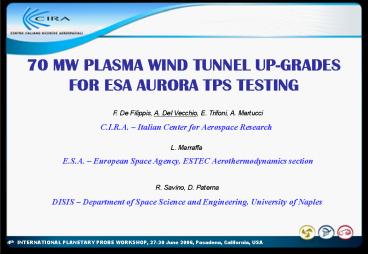Presentazione di PowerPoint - PowerPoint PPT Presentation
1 / 20
Title: Presentazione di PowerPoint
1
70 MW PLASMA WIND TUNNEL UP-GRADES FOR ESA
AURORA TPS TESTING
F. De Filippis, A. Del Vecchio, E. Trifoni, A.
Martucci
C.I.R.A. Italian Center for Aerospace Research
L. Marraffa
E.S.A. European Space Agency, ESTEC
Aerothermodynamics section
R. Savino, D. Paterna
DISIS Department of Space Science and
Engineering, University of Naples
2
Contents of the presentation
- SCIROCCO description
- Objectives of AURORA project
- Modifications on the facility
- Consequences on the performances
- Conclusions and next phases
3
Facility schema
4
Main facility components
70 MW Power Length of 5.5 m Max current 9000
Amperes Max voltage 30000 Volts
Twelve steam ejectors on three parallel
lines Total steam power of 80 MW hydrocarbon
energy
5
Objectives of feasibility study
Task 1 Modifications on the facility
WP 1100 Mars atmospheric entry
- Description of the modifications
- Plan of the modifications
- Consequences on the performances
- Schedule for the upgrade
- Cost of the modifications
Task 2 Instrumentation required
WP
- Definition of the necessary instrumentation
- Plans of the measurement techniques
- Schedule for the instrumentation
- Cost of the instrumentation
Task 3 Test plan
- Number of tests
WP 1200 Earth super-orbital re-entry
- Parameters measured
- Test conditions
- Measurement techniques and post-treatment
- Schedule and cost of the test campaign
6
Mars atmospheric entry (1)
Requirements ESA ExoMars mission
7
Mars atmospheric entry (2)
Atmosphere of Mars
Ar 1.5
N2 1.7
CO2 96.8
8
Modifications on SCIROCCO (1)
CO2 (max 2 Kg/s)
N2 (max 35 g/s)
9
Modifications on SCIROCCO (2)
Solutions for the CO gas system
Technical solutions for the CO2 N2 gas system
13.2 MW CO nominal
1 MW support methane
Compressed air piping electrically heat traced
10
Instrumentation (1)
Diode Laser Absorption Spectroscopy (DLAS)
Typical Diode Laser Absorption Spectroscopy
experimental setup
Spectral coverage of some laser diodes
11
Air and CO2 properties (1)
Thermal Conductivity
Air and CO2 transport properties are similar
Viscosity
Cp
Electrical Conductivity
12
Air and CO2 properties (2)
Radiation properties
13
CFD simulations (1)
The same specific total enthalpies and total
pressures as in air have been assumed at the
SCIROCCO nozzle inlet
The objective is to evaluate the stagnation point
pressure and the stagnation point heat flux on a
hemispherical fully catalytic probe (radius 5
cm). The nozzle F is considered, with an exit
section of 1.95 m diameter
14
CFD simulations
Fluid Dynamic model
A nine species (Ar, CO2, CO, C, O, O2, NO, N,
N2) gas model is taken into account to simulate
Mars atmosphere.
?
Each species of the mixture is assumed to behave
as a thermally perfect gas. Contributions to
species energy come from translational
rotational, vibrational electronic and chemical
energies. Different vibrational temperature are
used for each polyatomic species composing the
mixture. A harmonic oscillator model is used to
describe vibrational energies.
?
The rate at which vibrational energies relax
towards translational energies is assumed to
behave according to the Landau Teller model.
The vibrational relaxation time is derived from
the Millikan White formula, with Park
correction for high temperatures. Removal of
vibrational energy by means of dissociation and
effects of vibration on dissociation are not
taken into account.
?
Electronic energies are assumed in equilibrium at
the corresponding vibrational temperatures.
?
Chemical kinetic model is taken from Park (96).
Only the relevant reactions are taken into
account.
?
15
CFD simulations
Numerical solver
The FLUENT code solves the finite volume
formulation of the Navier Stokes equations
coupled to the thermo chemical equations.
?
Convective fluxes are computed according to Roes
Flux Difference Splitting scheme. Advection
Upstream Splitting Scheme AUSM is also available.
Up to 3rd order spatial accuracy may be achieved
by a MUSCL (Monotone Upstream Schemes for
Conservation Laws) TVD (Total Variation
Diminishing) formulation.
?
Diffusive fluxes are computed by the classic,
second order accurate, centered formulation.
?
Integration of the equations is performed
implicit in time, until steady state is achieved,
by means of an Algebraic Multigrid Linear solver.
?
The commercial solver has been used in this work
in combination with a number of ad hoc
developed user defined functions to model
hypersonic flows in chemical and vibrational
nonequilibrium.
?
16
CFD simulations (2)
Results
Probe surface heat flux W/m2
Temperature in the nozzle K
Temperature in the flowfield around the probe K
17
CFD simulations (3)
p02 vs p0
Stagnation point heat flux
18
Earth super-orbital re-entry
Return to Earth
? Velocity 11/12 km/s
? Stagnation pressure 105 Pa
? Heat flux 107 W/m2
19
Modification on SCIROCCO (1)
Usage of the only throat section to reach the
super-orbital Earth re-entry conditions in terms
of stagnation pressure and stagnation heat flux
Test Chamber
Test Chamber
Throat Section
Throat section
Conical Nozzle
20
Modification on SCIROCCO (2)
A new Model Support System is necessary to keep
the model at the necessary distance from the
throat section in order to reach the requirements
21
New performances (1)
Comparisons Heat flux vs p02 for all nozzle
configurations
(Throat section)
22
New performances (2)
23
Conclusions
- The facility modifications requested in order to
have Scirocco Plasma Wind Tunnel ready for Aurora
ESA Program are presented and discussed - Both goals, i.e. to simulate the Mars entry
conditions and the Earth super-orbital re-entry
conditions, are achievable through a set of
engineering modifications and solutions (
impacts, costs and time schedule estimated) - The ESA Agency is evaluating the feasibility
study. A decision for the following operative
phase resulting in the realization of the
modification judged necessary and mandatory is
expected within short time.































